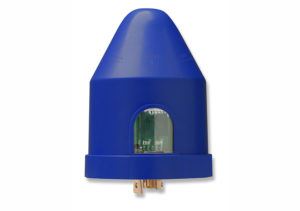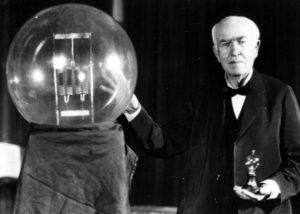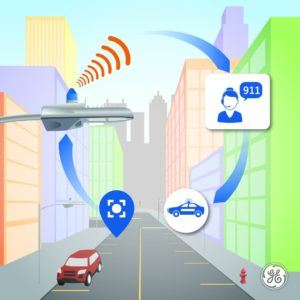Thriving Cities: GE’s Bright Idea

Have you heard of the newest GE business? Learn how Current, powered by GE is connecting streetlights and gunfire detection.
Edison Meet Light Bulb
Souruce: https://www.bostonglobe.com
General Electric. Thomas Edison. The light bulb. The three have an intertwined history over the 137 years since Edison invented the first commercially practical incandescent lamp1. In that time, GE has grown to be a multinational conglomeration with over 300,000 employees and technological innovations spanning many industries. However, in 2015 this iconic GE product embraced its most radical transformation yet with the creation of Current, powered by GE and Thriving Cities.
GE Meet LED
Our transformation begins with the LED.
Invented by GE scientists in the 1960’s, light-emitting diodes (LED) are highly energy efficient and have a lifetime 25x existing technology1. Although the initial upfront LED cost may be higher, the total lifetime cost is significantly lower. Considering these benefits, GE said goodbye to its compact fluorescent light bulb (CFL) business and hello to LED. Literally.
“Dear CFL,
I never imagined this day would come — but I’ve found another. Someone who helps me see my world in a whole new light. You don’t want to hear this, but I need to tell you… I’m in love. I’m in love with LED…. It’s bittersweet to admit that our relationship is over, but I can see clearly now that LED is my future and my future couldn’t be brighter.
Fondly yours, GE”2
LED Meet Digital
GE recognized the digital transformation available with the LED technology and created an entirely new business model. With this letter, GE announced their commercial lightening business was being spun-off from GE Lightening to create Current, powered by GE.
“We are Current, powered by GE. We’re a first-of-its-kind energy company, where world-class hardware technology meets unprecedented software technology. We combine GE’s LED, Solar, Energy Storage and Electric Vehicle capabilities with our Predix platform to deliver a 21st-century energy ecosystem to customers…Helping our customers reduce, produce, shift and optimize to transform their businesses and lives.3”
Current combines LED technology with digital capability to create intelligent infrastructures in a range of applications – optimized factory, the efficient office, the thriving city and the intuitive store3. This ‘21st-century ecosystem’ is supported by intelligent endpoints and Predix. Intelligent endpoints are devices and systems (sensors, motion detectors etc.) that can be installed into LED fixtures to collect valuable operational or environmental data3. Predix is GE’s cloud-based platform that collects and stores this data for analyzing and optimizing3.
Thriving City
While the digital lighting applications are diverse, GE’s Thriving City has the most transformation potential.
 The transformation began with San Diego, California. The city replaced 3,000 high-intensity discharge lamps (HID) with LEDs equipped with GE LightGridTM Wireless Control System (pictured to the right) backed by Predix4. This transformation has three important benefits.
The transformation began with San Diego, California. The city replaced 3,000 high-intensity discharge lamps (HID) with LEDs equipped with GE LightGridTM Wireless Control System (pictured to the right) backed by Predix4. This transformation has three important benefits.
- LED technology adds $250,000 annual savings though efficiency and maintenance improvements4.
- LightGridTM Wireless system allow remote control and monitoring of systems through nodes attached to each streetlight that are wirelessly connected to centralized servers.
- Predix enables ‘living’ cities where different components within the city can ‘talk’ and ‘coordinate’ 4.
Source: http://www.gelighting.com/
San Diego’s transformation is inspiring. But, it’s only the beginning. GE believes the potential LightGridTM applications are endless.
“Traffic lights could communicate with smart cars to find optimum routes. Weather sensors could prepare drainage systems for flooding. Motion detectors could interface with streetlights to deter criminals.4”
Lights and Gunfire
To fully capture the transformation potential, Current needs to adapt their Thriving City technology for localized applications. Globally, cities are incredibly diverse from physical characteristics (weather, population, infrastructure) to societal needs (crime rates, traffic). Current needs to develop solutions for all cities, not only developed downtown’s like San Diego. To accelerate adoption, they need to convince smaller cities or cities lacking capital that the upfront costs of LED and LightGridTM will allow societal improvements beyond simply the lifetime gains in efficient lighting.
A promising sign that Current is moving in this direction is seen in the partnership GE established with SST, Inc., a developer of gunfire detection and location technology5. Shotspotter sensors and software will now be offered as an add-on to GE’s LED technology to give street lights the ability to “detect gunfire in real time, connect to 911, alert police patrol cars, and ping smartphones with precise location of the shooting incident, the number of shooters and rounds fired.5”
With partnerships like this addressing specific problems in specific cities, GE can leverage universal technology to solve local problems. Soon, intelligent cities will simply be known as cities.
Source: http://www.gereports.com/12529-2/
(729 words)
End Notes
- General Electric, “Explore a Century of Innovation at GE,” http://www.ge.com/transformation/#light, accessed November 2016.
- com, “GE Lighting Say Goodbye to U.S. CFLS. http://www.cleveland.com/business/index.ssf/2016/02/ge_lighting_says_goodbye_to_us.html, accessed November 2016.
- Current, “A New Kind of Energy Company,” http://www.currentbyge.com/company/, accessed November 2016.
- GE Digital, “Bright Lights, Brilliant Cities, http://www.ge.com/digital/blog/bright-lights-brilliant-cities, accessed November 2016.
- GE Reports, “Listen to This! These “Intelligent” Street Lamps Can Hear Gun Shuts, Call For Help,” http://www.gereports.com/12529-2/, accessed November 2016.





Paige, this is fascinating stuff. The potential in these technologies is absolutely massive, and GE is as well-positioned as any company to work with local governments to actually implement these ideas. GE has their own self-driving car programs, solar, etc. but as these elements become more common around the country, does GE have a plan in place to interface with the Teslas and SolarCitys of the world? To have a truly connected network that benefits all its users, various companies and brands will have to “lower the shields” around their data and processes in order to effectively work together and achieve the true network effects available at large scale. It seems like GE is doing pretty incredible things on its own, and I’ll bet that the effects will increase exponentially if they can bring others onboard with this vision as well (as partners, not competitors).
I could see Thriving City technology being adapted to decrease automobile congestion in metropolitan areas. Most of the major metro areas in the US were founded over a century ago. Because the costs of overhauling existing roads, buildings, lighting systems, and other infrastructure are prohibitively high, the technology used by many public utilities is antiquated. By attaching smart-LED technologies to existing infrastructure, Current can harvest data regarding the most heavily traveled routes, peak hours of congestion, alternate routes, and locations of accidents. This data could then be used to develop a system in which traffic lights can “talk” to each other. This communication pathway can help optimize traffic light timing and redirect drivers to faster routes, thereby reducing overall commute times, and consequently, automobile exhaust.
Although this is a great technology, what seems to really be lacking here is a compelling case for adoption. I’m sure most cities view Predix and LEDs as nice to haves, but do they really solve a painpoint? Streetlights aren’t sexy and adoption will need to offer tangible benefits that cities just can’t live without. Barring a demonstration of substantial benefits, this will struggle to rise above being a show off technology.
I am excited to see the GE is helping make our cities “smarter” and is saying goodbye to energy inefficient CFL light bulbs. LED light bulbs are more energy efficient and as more and more cities adopt them, the environmental impact lighting our city streets decreases. Philips is also partnering with cities to get them to start using smart/connected LED light bulbs but they haven’t introduced a sensor like the GE/SST sensor. I’m curious to learn more about how the these GE/SST sensors are able to detect gunfire. What is the accuracy rate? Is there a risk that too many false-alarms will be triggered? It’s a very interesting idea and if the accuracy is high enough, I agree that it’s a great application of technology.